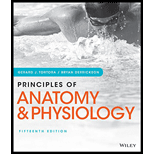
Concept explainers
To review:
The three main parts of a cell, following their functions.
Introduction:
The cells are considered as the basic functional and structural unit of an organism’s body. A cell is typically called as the building block of life, which aggregates to form tissue, organ, and organ system.
Explanation of Solution
The three different parts of the cell are mentioned below:
1. Plasma membrane: The outer surface that separates the internal and the external environment of a cell is called as plasma membrane or cell membrane. It is composed of a lipid bilayer, which is selectively permeable. It works as the barrier, in order to control influx and efflux of the molecules or ions across the cell.
2. Nucleus: It is the most important part of the cell. It consists of the hereditary information of the cell in the form of DNA. Furthermore, it controls all the activities of the cell, like growth, intermediary
3. Cytoplasm: The cytoplasm is the fluid present between the nucleus and the cell membrane. It comprises various organelles like ribosomes, mitochondria, centrioles, endoplasmic reticulum, lysosomes, and so on. It is the center for most of the cellular activities like protein synthesis, photosynthesis (in plants), and
Thus, the three main parts of the cell are nucleus, plasma membrane, and cytoplasm. Plasma membrane acts as the barrier between the cellular external and internal environment and allow selected molecules to cross through it. Nucleus control all the cellular activities as it contain the hereditary material i.e. DNA. Cytoplasm consist several organelles and acts as the center for most of the cellular activities.
Want to see more full solutions like this?
Chapter 3 Solutions
Principles of Anatomy and Physiology
 Human Anatomy & Physiology (11th Edition)BiologyISBN:9780134580999Author:Elaine N. Marieb, Katja N. HoehnPublisher:PEARSON
Human Anatomy & Physiology (11th Edition)BiologyISBN:9780134580999Author:Elaine N. Marieb, Katja N. HoehnPublisher:PEARSON Biology 2eBiologyISBN:9781947172517Author:Matthew Douglas, Jung Choi, Mary Ann ClarkPublisher:OpenStax
Biology 2eBiologyISBN:9781947172517Author:Matthew Douglas, Jung Choi, Mary Ann ClarkPublisher:OpenStax Anatomy & PhysiologyBiologyISBN:9781259398629Author:McKinley, Michael P., O'loughlin, Valerie Dean, Bidle, Theresa StouterPublisher:Mcgraw Hill Education,
Anatomy & PhysiologyBiologyISBN:9781259398629Author:McKinley, Michael P., O'loughlin, Valerie Dean, Bidle, Theresa StouterPublisher:Mcgraw Hill Education, Molecular Biology of the Cell (Sixth Edition)BiologyISBN:9780815344322Author:Bruce Alberts, Alexander D. Johnson, Julian Lewis, David Morgan, Martin Raff, Keith Roberts, Peter WalterPublisher:W. W. Norton & Company
Molecular Biology of the Cell (Sixth Edition)BiologyISBN:9780815344322Author:Bruce Alberts, Alexander D. Johnson, Julian Lewis, David Morgan, Martin Raff, Keith Roberts, Peter WalterPublisher:W. W. Norton & Company Laboratory Manual For Human Anatomy & PhysiologyBiologyISBN:9781260159363Author:Martin, Terry R., Prentice-craver, CynthiaPublisher:McGraw-Hill Publishing Co.
Laboratory Manual For Human Anatomy & PhysiologyBiologyISBN:9781260159363Author:Martin, Terry R., Prentice-craver, CynthiaPublisher:McGraw-Hill Publishing Co. Inquiry Into Life (16th Edition)BiologyISBN:9781260231700Author:Sylvia S. Mader, Michael WindelspechtPublisher:McGraw Hill Education
Inquiry Into Life (16th Edition)BiologyISBN:9781260231700Author:Sylvia S. Mader, Michael WindelspechtPublisher:McGraw Hill Education





